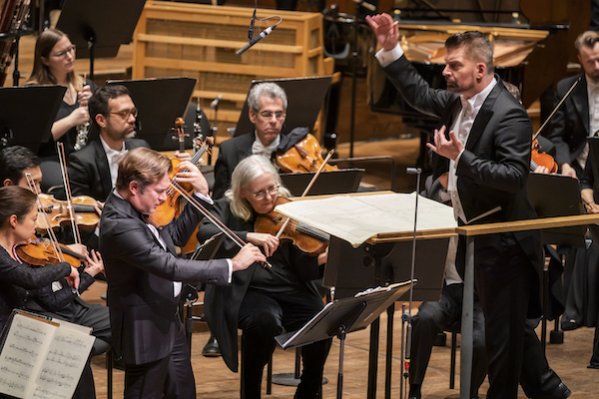Showpieces lacking in nuances with Pintscher, Philharmonic

Renaud Capuçon performed Matthias Pintscher’s “mar’eh” with the composer conducting the New York Philharmonic Thursday night at David Geffen Hall. Photo: Chris Lee
Concert warhorses are deceptively tricky: for the most part, concert staples have earned their place in the repertoire because they are reliably effective in performance. Yet it’s all too easy to take these works for granted and deliver a superficial interpretation that feels unsatisfying.
Such was the case on Thursday night, when composer-conductor Matthias Pintscher led the New York Philharmonic in a program that featured Stravinsky’s Firebird as its main draw.
The centerpiece of the program was the New York premiere of Pintscher’s own mar’eh for violin and orchestra. A concerto, more or less, the twenty-some-minute work takes its name from a Hebrew word that the composer interprets as a “sign” or “vision.” If that title seems nebulous, so is the music it describes: Pintscher opens with cold, glassy little fragments of ideas, combining harmonics in the solo violin part with chilly sounds from the woodwinds to create an icy feeling of disorientation. Figures in the orchestra and the solo part dance around each other, gradually taking shape as a whole.
Pintscher is terrific at writing intensity into a string part, and Renaud Capuçon was able to find virtuosic spirit in the jagged, barren sounds of the violin solo, especially in a rhapsodic quasi-cadenza. Yet unlike much of Pintscher’s other work, mar’eh lacks direction, wandering around, darting in this direction and that without ever settling on a goal. The one exception comes in its faster middle section, where a feeling of animation helps to create focus.
The evening began with Alborada del gracioso, the last movement of Miroirs, transcribed by Ravel himself into a peppy concert overture. Pintscher’s vision was unconvincing: this is a splashy piece, to be sure, with crashing cymbals and brass creating a bombastic overall impression. Yet as in so much of Ravel’s work, the real spirit of the music is in its details, the little coy gestures and turns of phrase that create a strong sense of character. These were largely neglected in Pintscher’s brash but flat interpretation, which ran past the intricacies of the work in chasing volume and power.
Stravinsky’s Firebird, given after intermission in its complete version, felt similarly shallow, at least in the early going. Pintscher built a strong crescendo from the start, but without a real feeling of suspense in the hushed opening bars, the build lost much of its effect. Sections that should have been more energetic felt scattered, such as the first appearance of the Firebird, where the ensemble frayed in depicting the Prince’s chase.
Even so, Stravinsky’s seminal ballet is so vivid that just the bare outline of the music can make for an exhilarating experience. Pintscher’s reading compelled through raw power rather than through precision of craft. The Philharmonic was in fine fettle in Thursday’s performance, creating electric motion in depicting the capture of the Firebird and following with lush, warm meshes in the appearance of the princesses.
The conductor was at his best where the scales and contrasts were at their grandest: the entire sequence at Kashchei’s Palace thrilled, from the violent stomping of the Infernal Dance through the haunting Lullaby, which rushed slightly but leaned into the tartness of the melody. Pintscher channeled ghostly shadows in the transition to the second tableau, finally unleashing the orchestra at full volume in the majestic closing bars.
Thursday’s program will be repeated Friday and Saturday at 8 p.m. at David Geffen Hall. The 2:30 p.m. matinee on Saturday will pair Firebird with pieces by Gounod and Ibert. nyphil.org


